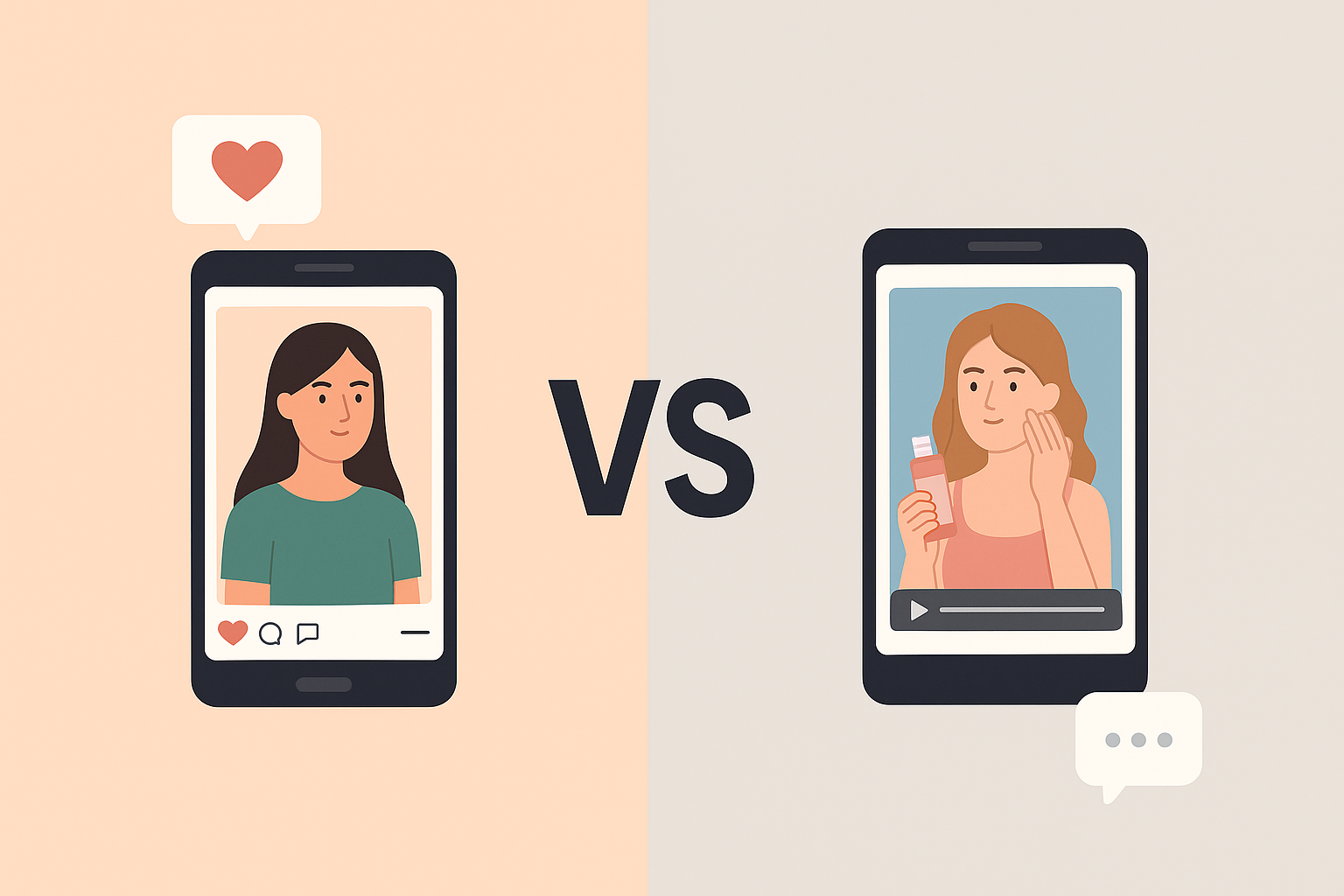How to Create an Influencer Marketing Campaign: Step-by-Step Strategy Guide for Brands

The influencer marketing industry has seen explosive growth, evolving from a $9.7 billion market in 2020 to a projected $33 billion industry by 2025. As brands increasingly recognise the power of authentic creator partnerships, the question is no longer whether to invest in influencer marketing, but how to create campaigns that deliver measurable results and a genuine return on investment.
The Current State of Influencer Marketing
Market Growth and Investment Trends
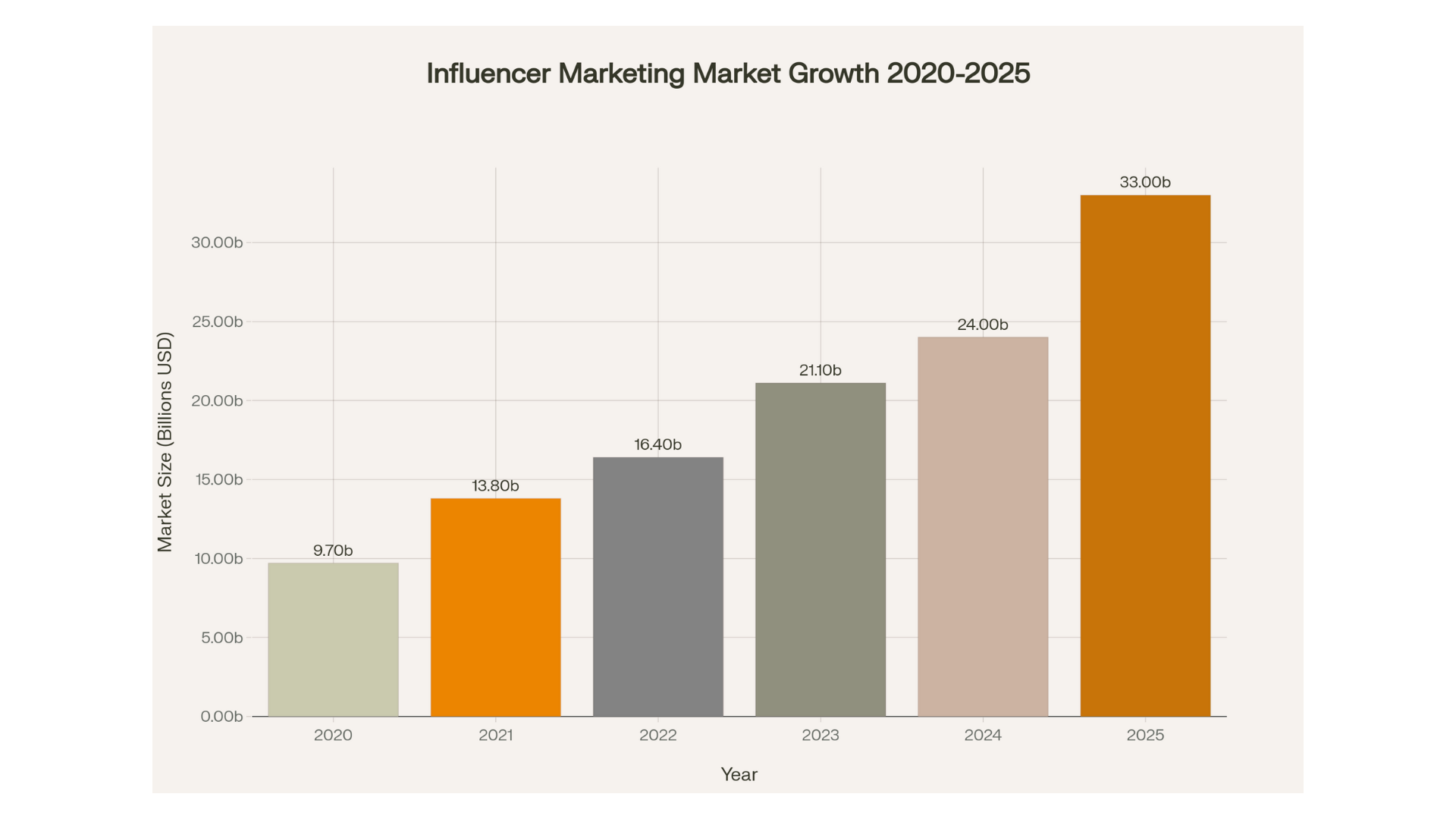
The numbers speak for themselves: 80% of brands either maintained or increased their influencer marketing budgets in 2025, with 47% raising budgets by 11% or more. This investment surge reflects a fundamental shift in how brands approach digital marketing, with 84% of brands believing influencer marketing to be effective (Dash, PR Newswire).
Content creators now command 25% of social media marketing budgets on average (House of Marketers). For the first time, ad revenue from user-generated content is set to surpass revenue from professionally produced media. This is a watershed moment where creator-led storytelling is outperforming traditional advertising formats.
Understanding ROI and Performance Metrics
The Financial Case for Influencer Marketing
Modern influencer marketing delivers impressive returns when executed strategically. Businesses earn an average of $5.78 for every dollar spent on influencer marketing, with the top 13% of businesses achieving an ROI of $20 or more. On Instagram specifically, brands see $4.12 return for every $1 spent (Sprout Social, InBeat).
Key Performance Indicators
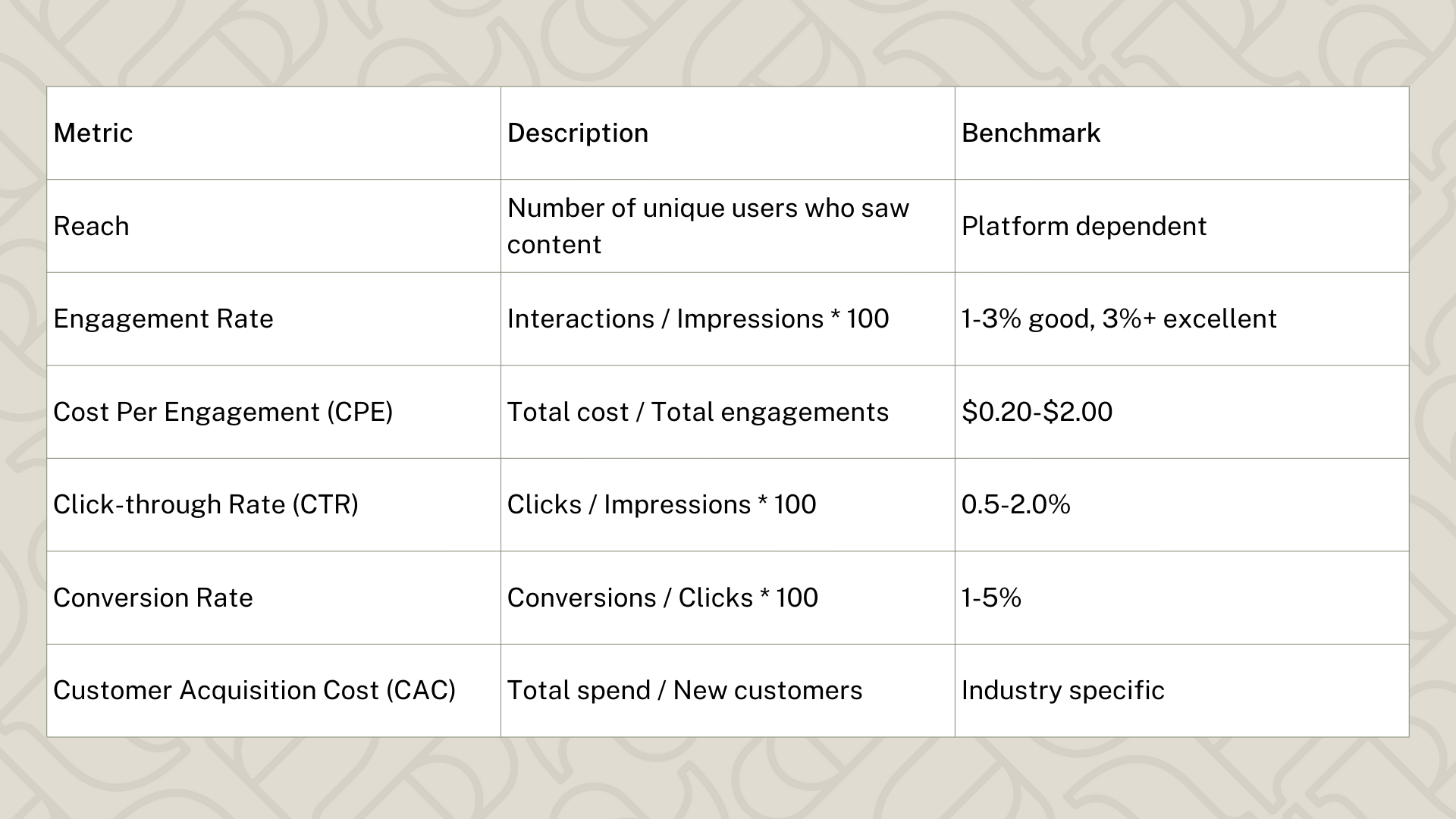
Essential metrics for measuring campaign effectiveness include:
- Engagement Rate: The gold standard for measuring content resonance
- Cost Per Engagement (CPE): Tracks efficiency of spend
- Conversion Rate: Measures actual business impact
- Customer Acquisition Cost (CAC): Evaluates long-term profitability
The Pepper Agency Approach: Strategic Framework
Based on Pepper Agency's methodology, effective influencer campaigns are built on four core pillars:
1. Smarter Creator Selection
A data-led approach ensures authenticity and ROI. The agency identifies creators based on:
- Audience fit and psychographics
- Performance data and engagement quality
- Brand alignment and authentic resonance
This reflects industry best practices, as 73% of brands prefer to work with micro and mid-tier creators, who offer the strongest engagement-to-cost ratio.
2. Trend-Aligned Briefing
Creator briefs shaped by live cultural trends, platform formats, and audience signals ensure content relevance and native fluency. This approach recognises that 65% of influencers want to be involved in the creative process rather than follow rigid briefs.
3. Performance-Driven Planning
Real-time monitoring of sentiment, reach, and engagement enables continuous optimisation of creator selection and content formats. This data-driven approach is crucial as 67% of consumers believe the key to successful brand collaborations is being honest and unbiased.
4. Impact Measurement
Linking influencer content to business goals such as awareness, engagement, and uplift - not just impressions or reach. This comprehensive measurement framework addresses the growing demand for accountability in influencer spending.
Influencer Tier Strategy and Engagement Analysis
The Power of Smaller Creators
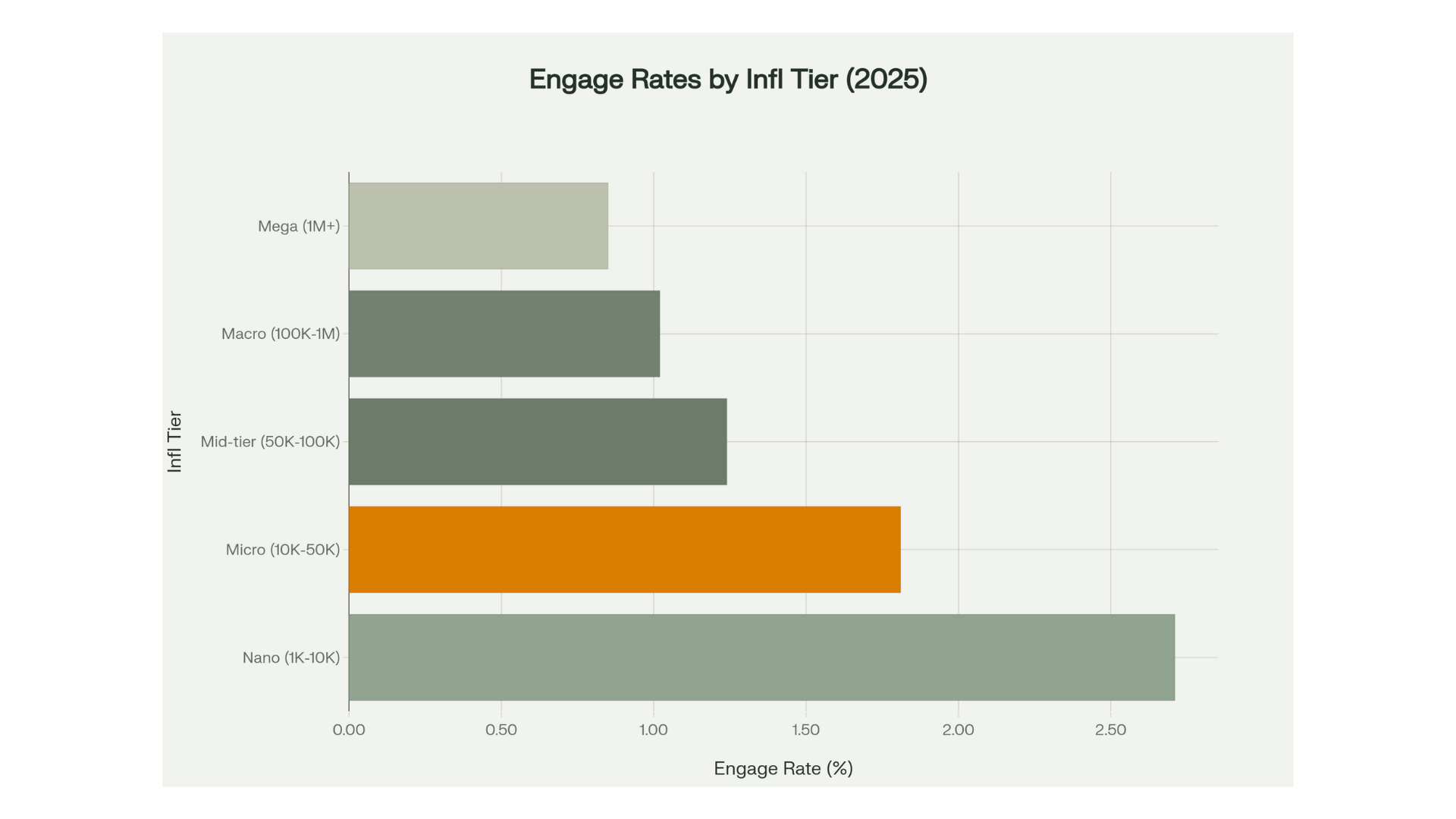
The data shows a clear inverse relationship between follower count and engagement rates:
- Nano-influencers (1K-10K followers): 2.71% engagement rate
- Micro-influencers (10K-50K followers): 1.81% engagement rate
- Mid-tier influencers (50K-100K followers): 1.24% engagement rate
- Macro-influencers (100K-1M followers): 1.02% engagement rate
- Mega-influencers (1M+ followers): 0.85% engagement rate
Nano-influencers generate 49.7% higher engagement than micro-influencers, while micro-influencers outperform mid-tier influencers by 46%. This data supports the trend towards smaller, more engaged communities.
Platform-Specific Strategy and Costs
Instagram: The Visual Powerhouse
Instagram remains dominant, with 10 million influencers available for partnerships.
Instagram Reels achieve the highest engagement with an average $2.65 CPE, making them particularly valuable for viral potential and algorithm visibility (PR Newswire).
TikTok: The Viral Engine
TikTok offers exceptional reach potential with over 88.3% user growth and strong engagement among Gen Z.
However, marketers' investment intentions for TikTok dropped by 17.2% following potential US regulatory challenges, highlighting the importance of platform diversification.
YouTube: Long-Form Value
YouTube commands premium pricing due to production complexity and extended content lifespan.
YouTube content provides strong value for product education, tech reviews, and in-depth demonstrations.
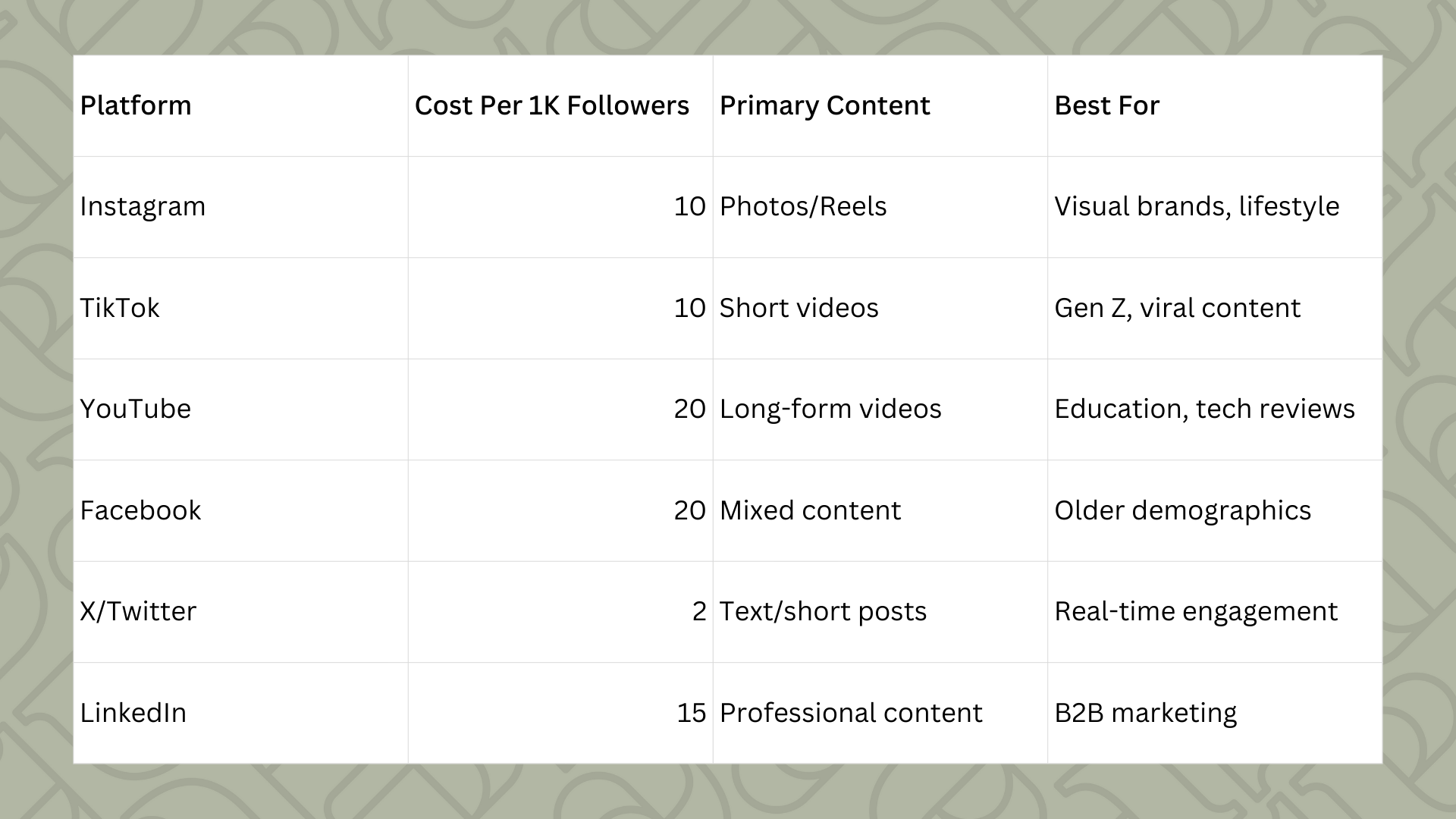
Budget Planning and Campaign Structure
Strategic Budget Allocation
Modern brands spread budgets across multiple tiers:
- 35% focus on multi-tier campaigns
- 25% invest in micro-influencer campaigns
- 20% pursue macro-influencer partnerships
Campaign Tier Frameworks
Starter Campaigns (UGC-Focused):
- Nano and micro influencer partnerships
- Product-only gifting or minimal fees
- Focus on authentic content collection
- Basic performance tracking
Mid-Tier Campaigns (Performance-Driven):
- Micro and macro influencer mix
- Affiliate tracking and performance bonuses
- Measurable ROI focus
- Long-term partnership development
Full-Service Campaigns (Comprehensive):
- Macro or celebrity partnerships
- Content licensing and paid amplification
- Strategic campaign management
- Multi-platform integration
Attribution and Performance Tracking
Modern Attribution Methods
Effective measurement requires sophisticated tracking beyond traditional metrics:
Multi-Touch Attribution: Recognises that purchase decisions involve multiple touchpoints, assigning credit throughout the customer journey.
Advanced Tracking Tools:
- Promo codes for direct attribution
- UTM parameters for traffic source tracking
- Post-purchase surveys to identify influence touchpoints
Customer Journey Mapping
Track influence across the complete funnel:
- Discovery Phase: Brand mentions and initial content exposure
- Consideration Phase: Product page views and wishlist additions
- Conversion Phase: Direct purchases through tracking links
- Retention Phase: Customer lifetime value and repeat purchase behaviour
Campaign Planning Checklist
Pre-Campaign Foundation
Goal Definition:
- Establish SMART objectives aligned with business goals
- Define success metrics and KPIs
- Set realistic timelines and milestones
Budget Planning:
- Allocate 60-70% to influencer fees
- Reserve 20-25% for content amplification
- Maintain 10-15% buffer for optimisation
Creator Selection:
- Analyse audience demographics and psychographics
- Review engagement quality and authenticity
- Assess brand alignment and content style
Campaign Execution
Content Strategy:
- Develop detailed creative briefs
- Define hashtag and mention requirements
- Establish content approval workflows
- Plan content repurposing and licensing
Performance Monitoring:
- Implement real-time tracking systems
- Monitor engagement and sentiment
- Track conversion attribution
- Adjust targeting based on performance data
Legal and Compliance
Contract Management:
- Define deliverables and usage rights
- Establish disclosure requirements
- Include performance clauses
- Plan for content ownership and licensing
Future Trends and Optimisation Strategies
AI Integration and Automation
92% of brands are using or open to using AI for influencer marketing workflows, including:
- Creator discovery and matching
- Performance prediction and optimisation
- Automated reporting and analysis
- Content personalisation
Long-Term Partnership Focus
47% of industry professionals advocate ongoing collaborations instead of one-off campaigns (Media Marketing). Long-term partnerships deliver:
- 71% of influencers offer discounts for extended partnerships
- Increased audience trust and authenticity
- Better content performance over time
- Reduced acquisition and onboarding costs
Performance-First Strategies
The industry shift towards performance-based compensation models including affiliate marketing and commission-based partnerships provides clearer ROI measurement. 51% of marketers report that influencer marketing helps acquire better customers, not just more customers.
Key Success Factors
Content Quality Over Quantity
64% of consumers believe genuine reviews are the most effective influencer content type. This underlines the importance of authenticity over production value. Gifted collaborations deliver 12.9% more engagement than paid partnerships (2.19% vs 1.94%), showing that authentic enthusiasm trumps monetary incentives (Sprout Social).
Niche Alignment Impact
Niche alignment boosts campaign performance significantly, with matched campaigns seeing 13.59% higher engagement and 81.39% more views. This data reinforces the importance of creator-brand fit over follower count (The Social Cat).
Multi-Platform Approach
59% of marketers plan to partner with more influencers in 2025 as consumers explore new social platforms. Successful campaigns now require cross-platform strategies that follow audiences wherever they consume content (Marketing Dive).
Conclusion
Creating effective influencer marketing campaigns in 2025 requires a sophisticated, data-driven approach that prioritises authentic relationships over vanity metrics. The most successful brands are those that:
- Invest in long-term creator partnerships instead of one-off campaigns
- Focus on engagement quality over follower quantity
- Implement comprehensive attribution tracking to measure true ROI
- Diversify across multiple platforms and creator tiers
- Integrate AI tools for optimisation and scaling
With 86% of consumers making influencer-inspired purchases at least once per year, the opportunity for brands is substantial. However, success requires strategic planning, performance measurement, and genuine commitment to authentic creator partnerships.
The brands that will dominate influencer marketing in 2025 and beyond are those that treat it not as a tactical add-on, but as a core component of their customer acquisition and retention strategy - one that delivers measurable business results while building lasting relationships with both creators and customers.
Explore Our Latest Insights
Stay updated with our latest articles and resources.





Ready to elevate your marketing strategy?
Let’s add some spice to your next campaign 🌶️

